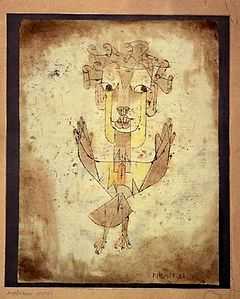Angelus Novus

Angelus Novus
Angelus Novus is mono print or oil transfer method invented by and executed by Paul Klee in 1920. It is now in the collection of the Israel Museum in Jerusalem.
In his ninth thesis in the essay “Theses on the Philosophy of History,” Walter Benjamin, who owned the print for many years, describes:
A Klee painting named Angelus Novus shows an angel looking as though he is about to move away from something he is fixedly contemplating. His eyes are staring, his mouth is open, his wings are spread. This is how one pictures the angel of history. His face is turned toward the past. Where we perceive a chain of events, he sees one single catastrophe which keeps piling wreckage upon wreckage and hurls it in front of his feet. The angel would like to stay, awaken the dead, and make whole what has been smashed. But a storm is blowing from Paradise; it has got caught in his wings with such violence that the angel can no longer close them. The storm irresistibly propels him into the future to which his back is turned, while the pile of debris before him grows skyward. This storm is what we call progress.[1]
Otto Karl Werckmeister has commented that Benjamin's interpretation of the angel has led to it becoming "an icon of the left".[2]
The name and concept of the angel has inspired works by other artists and musicians.[3][4]
References
- ↑ Benjamin, "Theses on the Philosophy of History", p. 249.
- ↑ Werkmeister, Icons of the Left: Benjamin and Einstein, Picasso and Kafka After the Fall. Chicago: University of Chicago Press, 1997; pp. 9.
- ↑ "zing6 - reviews - angelus nova". Zing Magazine. 1997. Retrieved 9 October 2012.
- ↑ "Seventh Munchener Biennale". 4–19 May 2000. Retrieved 9 October 2012.